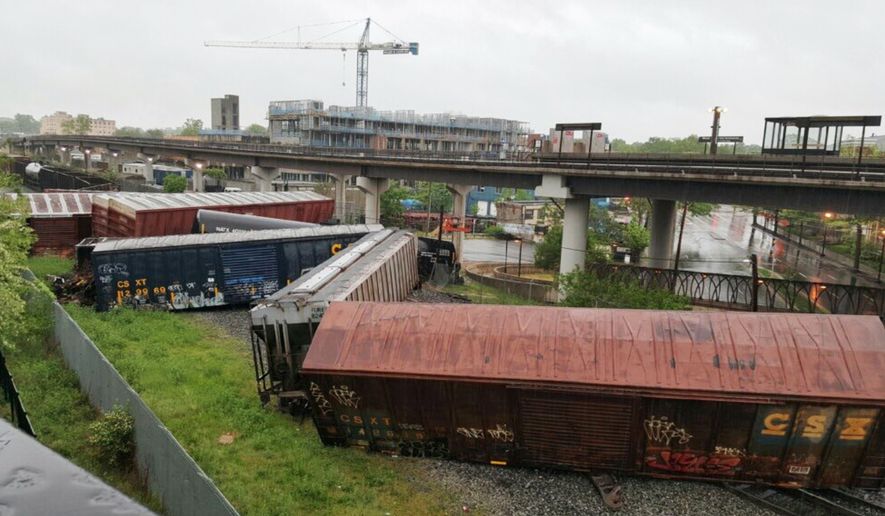Fifteen cargo cars on a CSX freight train derailed Sunday morning near a subway station in Northeast, and one of the cars leaked a corrosive chemical, D.C. officials said.
No injuries were reported in the train derailment, which occurred about 6:40 a.m. near the Rhode Island Avenue Metro station. Officials temporarily closed the subway station, but did not evacuate the neighborhood. Nevertheless, Montgomery County residents could see major disruptions in their commute Monday.
CSX spokeswoman Kristin Seay said that one of the cars leaked sodium hydroxide, commonly known as lye, which is used to produce various household products including paper, soap and detergents.
“The fumes should not cause you any problems and you should not be able to smell them anywhere else,” D.C. Deputy Fire Chief John Donnelly said.
Chief Donnelly said firefighters quickly plugged up the hole to contain the spill, but he didn’t know how much of the lye had been emptied from the car.
D.C. Council member Kenyan McDuffie of Ward 5, where the accident occurred, said that the leak was contained and sealed by 11 a.m.
“Please note that Rhode Island Avenue is closed from 4th to 12th streets and the Rhode Island Avenue-Brentwood Metro Station on the Red Line is also closed,” Mr. McDuffie said in a statement. “Metro will establish bus shuttle service between the NoMa and Brookland Metro stations.”
D.C. Mayor Muriel Bowser said that city fire and CSX officials had not determined what caused the 175-car train to jump the tracks on its route from Cambridge, Maryland, to Hamilton, North Carolina. About 95 of the cars were carrying chemical materials at the time of the accident.
The Federal Railroad Administration is taking the lead on the investigation, Ms. Bowser said.
The mayor did not indicate when Metro service would resume between the NoMa and Brookland stations, but she did say Metro workers were inspecting the subway tracks near the derailment.
Lye can cause severe burns to the eyes, skin and mucous membranes, according to the National Institutes of Health. Inhaling sodium hydroxide dust can cause upper respiratory and lung damage ranging from just a mild nose irritation to pneumonitis, which is the inflammation of lung tissue.
The Federal Railroad Administration is working with CSX, MARC and Amtrak to figure out when service will be restored since the three rail carriers share the same track.
Metro hoped to have red-line service back to normal Sunday evening, but MARC officials said their service won’t recover that quickly.
Officials with the Maryland commuter rail said their Brunswick Line, which runs from Union Station through Montgomery County and up to Martinsburg, West Virginia, will suffer major disruptions Monday, likely not running beyond Silver Spring. They urged residents to find some other way to get to work.
Chris Nellum told The Associated Press that he lives near the site of the derailment and his window looks directly over the railroad tracks.
“I thought it was like a semi-truck coming toward the building and when I looked out the window, I saw cars piling up,” said Mr. Nellum, who had just moved in the night before. “So I’m not even used to hearing trains. It was jarring.”
• Ryan M. McDermott can be reached at rmcdermott@washingtontimes.com.




Please read our comment policy before commenting.